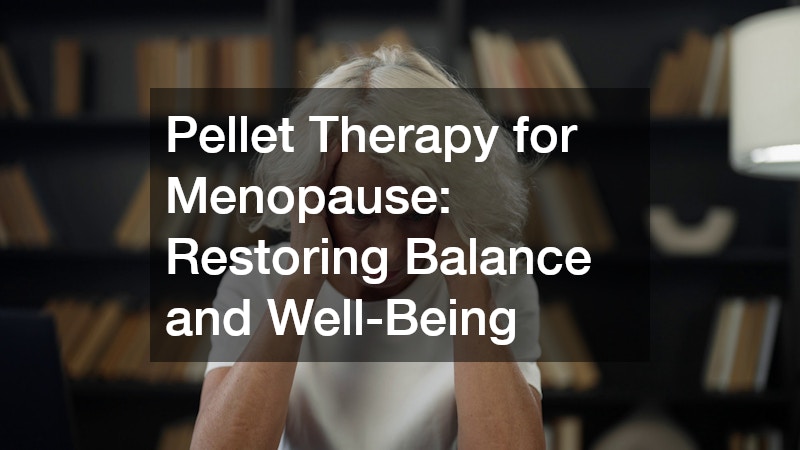

Menopause is a natural stage in a woman’s life, typically occurring between the ages of 45 and 55, when the ovaries reduce hormone production, and menstrual cycles come to an end. While it is a normal biological process, the changes in hormone levels—particularly estrogen and progesterone—can cause a variety of symptoms that affect daily life. Hot flashes, mood swings, weight fluctuations, fatigue, and changes in sleep patterns are common, and for many, these symptoms can feel overwhelming.
One approach gaining attention for its effectiveness and convenience is pellet therapy. This method of hormone replacement offers a steady, consistent release of bioidentical hormones into the body, helping address symptoms and improve overall quality of life during menopause.
Understanding Hormonal Changes During Menopause
During menopause, the body experiences a significant decrease in estrogen and progesterone production. These hormones influence many systems, including mood regulation, bone density, cardiovascular health, and even skin elasticity.
The drop in hormones can trigger a range of physical and emotional symptoms. Some women experience only mild discomfort, while others deal with more severe issues such as brain fog, joint pain, or decreased libido. Because the changes happen gradually over time, it can be difficult to pinpoint when symptoms are directly tied to menopause. This is where hormone therapy comes into play, aiming to restore balance and alleviate the challenges caused by hormone decline.
What Is Pellet Therapy?
Pellet therapy is a form of bioidentical hormone replacement therapy (BHRT). The pellets, which are about the size of a grain of rice, contain hormones chemically identical to those the body naturally produces. They are inserted just beneath the skin, usually in the hip area, through a quick in-office procedure.
Once inserted, the pellets slowly release hormones into the bloodstream over several months. This mimics the body’s natural hormone delivery system more closely than some other methods, such as oral pills or patches, which may cause fluctuations in hormone levels throughout the day.
The consistent release of hormones can help minimize the highs and lows that sometimes occur with other forms of hormone replacement, providing more stable symptom relief.
Benefits of Pellet Therapy for Menopause
Many women turn to pellet therapy because it offers both convenience and effectiveness. Here are some of the potential benefits:
1. Consistent Hormone Levels
Pellets release hormones continuously, avoiding the peaks and crashes that can occur with other delivery methods. This stability may help reduce mood swings, improve energy levels, and promote more restful sleep.
2. Reduced Menopausal Symptoms
Hot flashes, night sweats, and vaginal dryness are some of the most common complaints during menopause. By restoring hormone levels, pellet therapy can help ease these symptoms and improve overall comfort.
3. Enhanced Mental Clarity and Mood
Hormonal fluctuations can affect brain function, leading to forgetfulness, difficulty concentrating, or irritability. Balanced hormones may support clearer thinking and a more stable mood.
4. Improved Bone and Heart Health
Estrogen plays a key role in maintaining bone density and supporting cardiovascular health. Replenishing hormone levels may contribute to stronger bones and a healthier heart as women age.
5. Convenience
Unlike daily pills or weekly patches, pellets only need to be replaced every few months, making it a low-maintenance option for those with busy lifestyles.
The Pellet Therapy Process
Before starting pellet therapy, a healthcare provider will typically perform a thorough evaluation. This may include reviewing symptoms, discussing medical history, and running lab tests to measure current hormone levels.
Once a treatment plan is developed, the pellet insertion procedure can be completed in a matter of minutes. After the skin is numbed, a small incision is made, and the pellet is placed under the skin. The incision is then closed with a bandage.
Over the next several months, the pellet gradually dissolves as it delivers hormones into the bloodstream. Follow-up appointments allow the provider to monitor progress and adjust dosage if necessary.
Is Pellet Therapy Right for Everyone?
While pellet therapy can be a helpful solution for many women experiencing menopausal symptoms, it may not be suitable for everyone. Certain medical conditions, such as specific hormone-sensitive cancers or blood clotting disorders, could make this form of therapy less advisable.
A personalized consultation with a healthcare professional is essential to determine if pellet therapy is the best approach. This ensures the treatment is tailored to individual needs and health considerations.
Lifestyle Considerations for Menopause Relief
While pellet therapy can be an effective tool in managing menopausal symptoms, combining it with healthy lifestyle habits may enhance results. Some strategies include:
-
Balanced Nutrition: Focus on whole foods rich in fiber, lean proteins, and healthy fats to support overall health and hormone balance.
-
Regular Exercise: Activities like strength training, yoga, and walking can help maintain bone density, reduce stress, and improve mood.
-
Stress Management: Practices such as meditation, deep breathing, or journaling may reduce anxiety and promote emotional well-being.
-
Adequate Sleep: Prioritizing restful sleep can aid in hormonal regulation and energy restoration.
By pairing hormone therapy with these habits, women can take a comprehensive approach to navigating menopause.
If menopausal symptoms are interfering with daily life, speaking with a qualified healthcare provider about pellet therapy may be the first step toward feeling like yourself again. With the right treatment and lifestyle choices, this stage of life can be approached with energy, confidence, and vitality.



